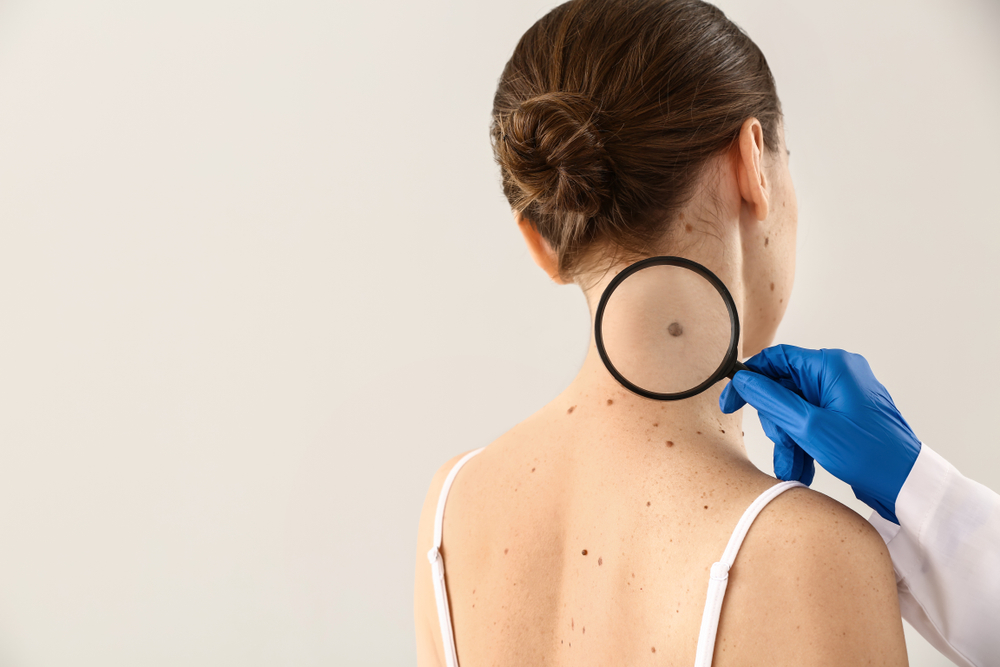Birthmarks are a part of everyday life for many people and, unless they’re very noticeable, we tend not to think about them very much. However, in both a scientific sense and a spiritual sense they can actually vary greatly, and also hold quite a lot of meaning. In this article, we’ll explore birthmarks in a general sense, beginning with the scientific viewpoint, and moving on to spiritual symbolisms.
What is a Birthmark?
Scientifically, a birthmark is just a coloured mark, spot or lesion on the skin. Birthmarks can appear anywhere on the body, and be present right from the moment someone is born, or appear shortly after birth. They vary greatly in terms of size, shape, and colour (e.g. pink, red, brown, black, blue, etc) with some being flat and smooth, and others having a raised texture.

Some birthmarks may be very small and hardly noticeable. Others may be larger and much more apparent. The appearance of a birthmark can also change over time. Some become lighter, or even disappear, while others may grow darker or more prominent.
The two main types of birthmarks are pigmented birthmarks and vascular birthmarks.
Pigmented Birthmarks: These occur within an area of skin that has too many pigment cells. Pigmented birthmarks can take the form of:
- Moles - can be flat or raised; permanent or temporary. Moles come in a wide range of colours and can appear anywhere on the body. Changes to moles can be linked to cancer, so it’s important to keep an eye on any that you may have.
- Café au lait spots - French for “coffee with milk”, these are irregularly-shaped pale-brown (or sometimes black) skin spots that range in size. They often fade with age.
- Mongolian spots - blue-ish grey blemishes that often appear on the lower back or buttocks. Sometimes mistaken for bruising, these marks are more common on babies with darker skin, and can fade with age.
Vascular Birthmarks: These are caused by abnormal or malformed blood vessels in the skin. Vascular birthmarks can take the form of:
- Salmon patches - red/pink patches that are sometimes called angel’s kisses (on the forehead, nose, lip or eyelids) or stalk bites (on the back of the neck). Can disappear with age.
- Hemangiomas - pink, blue or red marks on the head, neck, or extremities. They appear early in life and grow rapidly for up to 9 months, but then often fade as someone grows into adulthood.
- Port-wine stains - most commonly found on the face, neck, arms or legs. Also called nevus flammeus, these pink, red or purple marks don’t fade, and can become heavily textured over time.
How to Get Rid of Birthmarks
Most birthmarks are harmless and don’t need treatment. However, in rarer cases they can be associated with underlying medical conditions, such as cancer. Sometimes, people may also have cosmetic concerns relating to birthmarks, and so they seek advice from a healthcare provider.
Birthmarks that persist or become more noticeable over time can be treated in accordance with their type, size and location. When it comes to monitoring birthmarks, you should look for changes in:
- Size.
- Colour.
- Shape.
- Elevation.
- Texture.
It’s vital to consult with a healthcare provider or dermatologist who can recommend suitable treatment options for a birthmark, but some common ways to remove them include:
- Laser Therapy: Targets and shrinks the blood vessels that cause a birthmark: especially vascular ones like port-wine stains. Most effective in infancy.
- Surgery: An option for some types of birthmarks, especially if they are large or causing functional problems.
- Medications: Used to treat some types of birthmarks by shrinking blood vessels and reducing blood flow. A common example is using beta blockers for hemangiomas.
- Topical Treatments: Options like corticosteroid creams may be used to treat certain types of birthmarks, especially if they’re small and not particularly problematic.
It's important to re-emphasise that not all birthmarks require treatment. In some cases, treatment may not be recommended at all. Your healthcare provider can help you determine the best course of action based on your individual circumstances. Some people even grow rather attached to their birthmarks, and come to love them as a unique part of their body!

Does Everyone Have a Birthmark?
No, not everyone has a birthmark. Approximately one in three babies are born with one. The presence of birthmarks is determined by genetic and environmental factors, and - as you might expect - such factors vary widely between people. Some birthmarks are hereditary, and you can see similar patterns within the same family, but this certainly isn’t the norm!
What Does a Birthmark Mean?
In most cases, birthmarks don’t mean anything specific, but are simply physical characteristics. They’re not usually associated with any particular medical or psychological condition.
However, some cultures hold birthmarks to be highly significant! For example, a birthmark on a certain part of the body could be considered to be a sign of good luck or fortune, or even a physical indicator that a person possesses a particular personality trait or skill in abundance.
Common Birthmark Shape Meanings
It's important to note that, while some people may attach meaning to birthmarks, there is no scientific evidence to support these interpretations. However, there are quite a few common birthmark shapes that hold meaning to certain cultures and belief systems. These include:
- Heart-shaped: Often believed to be a sign of good luck, love, or affection.
- Star-shaped: Can be interpreted as a sign of good fortune or a special talent.
- Diamond-shaped: Sometimes believed to be a sign of wealth, success, or fortune.
- Circular: Can be taken to represent a sign of protection or healing.
Some belief systems also ascribe significance to the location of a birthmark:
- Forehead: Believed to symbolise outstanding intelligence or knowledge. On the left side of the forehead, it’s also thought to suggest spontaneity and creativity.
- Eye: Often thought to show that someone may have a gift for perceiving things clearly or reading between the lines.
- Neck: May suggest that someone has been silenced in a past life, but is now ready to speak their truth.
- Breast: Can show that someone is guided by their heart, and also be a sign of great triumph in work or life.
- Shoulder Blade: Is believed to mark out someone with a particularly strong calling in life.
- Arm: Thought to represent that someone has embraced their own destiny, and won’t allow themselves to be dominated by external factors.
- Stomach: Some believe that a stomach or abdomen birthmark can represent greed, but it’s also attributed to an ability to tune into the “gut-feelings” that guide our lives.
- Thigh: Can indicate that someone is lucky, and suggests that they will be blessed with health and wealth.
- Leg: Sometimes believed to indicate that a person will need to learn to stand firm, and not be dependent on others.
- Foot: Believed to symbolise that someone is a fighter!
It’s worth reinforcing that spiritual explanations for birthmarks are highly personal, and no two people will be able to ascribe exactly the same experience to themselves, which is just one reason why they’re such a fascinating topic to discuss!





